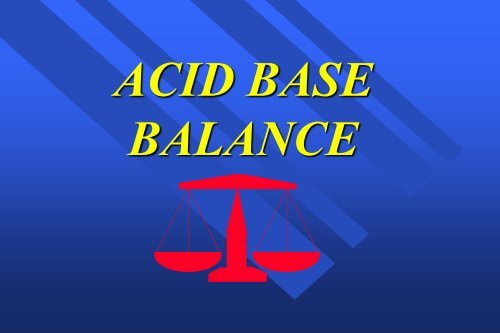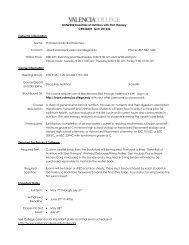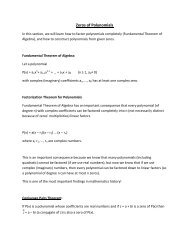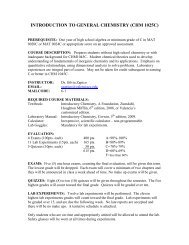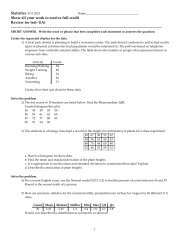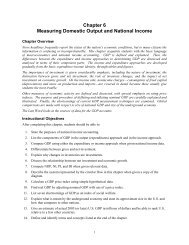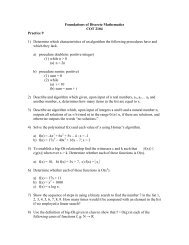ACID BASE BALANCE
ACID BASE BALANCE
ACID BASE BALANCE
You also want an ePaper? Increase the reach of your titles
YUMPU automatically turns print PDFs into web optimized ePapers that Google loves.
<strong>ACID</strong> <strong>BASE</strong><br />
<strong>BALANCE</strong>
<strong>ACID</strong> <strong>BASE</strong> <strong>BALANCE</strong><br />
• General Principles<br />
– Dynamic relationship which reflects the<br />
concentration of hydrogen (H+) ions<br />
– Hydrogen ions are acids which must be<br />
maintained within strict limits<br />
» Any deviation from norm affects biochemical<br />
events<br />
– Measured in a negative log (pH) which is<br />
inversely proportional to the hydrogen ion<br />
concentration<br />
» High H+ ion concentration = Low pH<br />
» Low H+ ion concentration = High pH
THE pH SCALE<br />
• Most frequently used measure of acid base balance<br />
• Ranges from 1-14<br />
– 1 means only hydrogen ions present<br />
– 14 means no hydrogen ions present<br />
– pH of water is 7.0 (neutral)<br />
• pH of human body is 7.35-7.45<br />
• pH compatible with life = 6.9-7.8<br />
– pH of < 7.35 indicates a state of acidosis<br />
– pH of > 7.45 indicates a state of alkalosis<br />
– Variation of 0.4 in either direction can be fatal
Acid-Base Balance<br />
• A pH below 7.35 is<br />
referred to as<br />
acidosis<br />
• A pH above 7.45 is<br />
referred to as<br />
alkalosis
• Body constantly produces acids through<br />
metabolism<br />
– Carbon dioxide<br />
– Metabolic acids (lactic and pyruvic acid)<br />
• Acids must be constantly eliminated from the body<br />
– As acids increase, bodily functions decrease<br />
– Example<br />
» Diminishes myocardial contractility<br />
» Reduces vascular response to catecholamines<br />
» Interferes with the actions of<br />
pharmacological agents
BUFFER SYSTEM<br />
• Fastest acting defense mechanism (seconds)<br />
• Chief buffer is bicarbonate<br />
– Bicarbonate combines with excess hydrogen ions to form<br />
carbonic acid in a dynamic relationship:<br />
HCO3 + H+ H2CO3<br />
– For every molecule of carbonic acid, there are 20 molecules<br />
of bicarbonate<br />
– Any change in 20:1 ratio is immediately corrected to<br />
maintain pH<br />
» An increase in H+ causes an increase in H2CO3<br />
» A decrease in H+ causes a decrease in H2CO3
Bicarbonate Buffer System<br />
• Fastest mechanism<br />
• Hydrogen will bind with bicarbonate<br />
• Results in formation of carbonic acid<br />
Hydrogen<br />
<br />
<br />
H HCO H CO<br />
3 2 3<br />
ion bicarbonate ion carbonic<br />
acid
Carbonate Buffer System<br />
• An increase in hydrogen ions leads to an increase<br />
in carbonic acid.<br />
• A deficit in hydrogen ions (alkalosis); carbonic<br />
acid will dissociate into bicarbonate ion and<br />
hydrogen ion<br />
Increased<br />
Decreased<br />
Acid: <br />
H<br />
<br />
Acid: H<br />
<br />
<br />
<br />
HCO<br />
<br />
3<br />
HCO<br />
<br />
3<br />
H<br />
2<br />
H<br />
CO<br />
2<br />
3<br />
CO<br />
3
BUFFER SYSTEM (CONT.)<br />
• Carbonic acid is a weak, volatile acid<br />
which must be eliminated<br />
• Enzyme carbonic anhydrase<br />
catalyzes the carbonic acid to<br />
convert to carbon dioxide and water:<br />
H2CO3--------->CO2 + H2O<br />
• CO2 and H2O are easily eliminated<br />
by the lungs and kidneys
• Functions within minutes (1-3)<br />
• Lungs eliminate excess CO2 by<br />
increasing respirations, causing a<br />
decrease in H+ ion and an increase in<br />
pH<br />
• Lungs can retain more CO2 by<br />
decreasing respirations, causing an<br />
increase in H+ ions and a decrease in<br />
pH
Respiratory Mechanisms<br />
• Increased respirations cause increased elimination of CO 2<br />
and H 2 O.<br />
– An increase in pH<br />
• Decreased respirations cause retention of CO 2 and H 2 O.<br />
– Decreasing pH
• Slowest onset and generally important in<br />
long term maintenance of acid-base<br />
balance (hours to days)<br />
• Function<br />
– Kidneys retain bicarbonate, causing a<br />
decrease in H+ ions and an increase in pH<br />
– Kidneys excrete bicarbonate, causing an<br />
increase in H+ ions and a decrease in pH
Respiratory Acidosis<br />
• Caused by abnormal retention of CO 2 from<br />
impaired ventilation due to problems<br />
occurring in the lungs or respiratory center<br />
of the brain<br />
Respiration = CO 2 + H 2 O H 2 CO 3 H + + HCO 3<br />
-
Respiratory Alkalosis<br />
Caused by increased respiration and<br />
excessive elimination of CO 2<br />
The CO 2 level is decreased and the pH is<br />
increased.<br />
Respiration = CO 2 + H 2 O H 2 CO 3 H + + HCO 3<br />
-
<strong>ACID</strong>-<strong>BASE</strong><br />
DERANGEMENTS (CONT.)<br />
• Metabolic acidosis<br />
– Increased production of acids (lactic and pyruvic)<br />
– Can also result from diarrhea, vomiting, diabetes and<br />
medications (ASA)<br />
– pH is decreased and CO2 level is normal<br />
– Treatment is aimed at improving ventilations to<br />
eliminate CO2<br />
– Sodium bicarbonate with documented metabolic<br />
acidosis<br />
» Rarely administered during initial resuscitative<br />
strategies
<strong>ACID</strong>-<strong>BASE</strong><br />
DERANGEMENTS (CONT.)<br />
• Metabolic alkalosis<br />
– Caused by increased vomiting, overdosing on<br />
antiacids, diuretics<br />
– pH is increased and CO2 remains normal<br />
– Treatment is aimed at underlying cause<br />
• Combinations<br />
– Any combination of acid-base derangements<br />
– Only ABG can accurately diagnose problem
Thank you!


